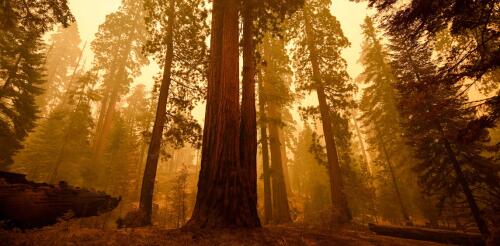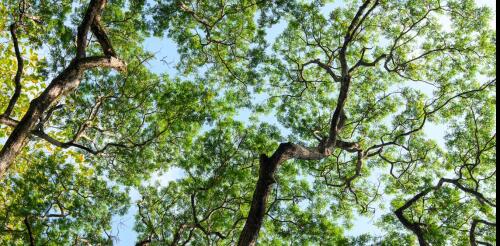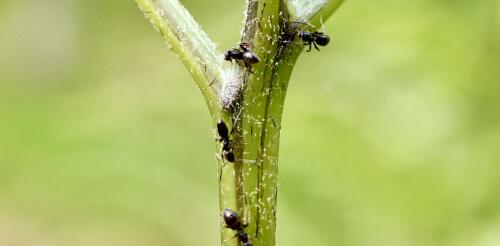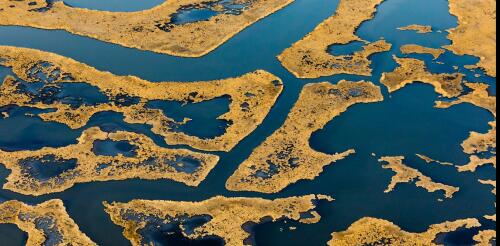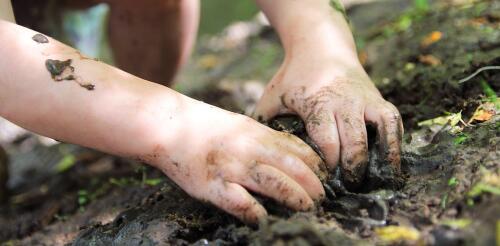Plants
When wildfire smoke is in the air, doctors urge people to stay indoors to avoid breathing in harmful particles and gases. But what happens to trees and other plants that can’t escape from the smoke? They respond a bit like us, it turns out: Some trees essentially shut their windows and doors and hold their breath. As atmospheric and chemical scientists, we study the air quality and ecological effects of wildfire smoke and other pollutants. In a study that started quite by accident when smoke overwhelmed our research site in Colorado, we were able to watch in real time how the leaves of living pine trees responded. How plants breathe Plants have pores on the surface of their leaves called stomata. These pores are much like our mouths, except that while we inhale oxygen and exhale carbon dioxide, plants inhale carbon dioxide and exhale oxygen. A highly magnified view of stomata in a maize leaf. Umberto Salvagnin/Fli...
When you walk through a forest, it may feel like a static setting where very little is happening. But trees are constantly interacting and reacting to each other as they grow. There’s intense competition for light and space. Every shift affects the overall makeup of the forest in some way. Forest scientists like me spend a lot of time thinking about forest succession – a predictable process in which plant species colonize and dominate a piece of land. The basic sequence is for land to evolve from an open field to brush and shrubs, then to young trees and ultimately to large, mature trees. Disturbances, such as a major storm or wildfire, can interrupt or set back forest succession. I study ecological changes in species composition, tree arrangement and forest development that occur during succession and after disturbances. My research team analyzes conditions in mixed-species deciduous, or leafy, forests. Using tree rings, we reconstruct what previous forests looked l...
Look closely at a plant in your local park, your garden or even your kitchen, and you’re likely to see some damage. Whether a caterpillar has chewed away part of a leaf or a mealybug is sucking on sap, animals are constantly feeding on plants. Of course, herbivory, or plant predation, is not ideal for a plant’s survival. So plants have evolved many different defense mechanisms to inhibit this threat, including physical and chemical weapons. For example, cactuses arm their bodies with skin-piercing spines. Herbs such as mint, lavender and rosemary produce volatile scent compounds that can help deter herbivores. Other plants resort to bribing personal bodyguards by secreting thick, sweet nectar. Nectar is most commonly associated with flowers, where it is used to entice bees, birds or butterflies to move pollen from one flower to another. But other plants produce different types of nectar glands called extrafloral nectaries. Plants produce these glands to bribe ants...
Wetlands have flourished along the world’s coastlines for thousands of years, playing valuable roles in the lives of people and wildlife. They protect the land from storm surge, stop seawater from contaminating drinking water supplies, and create habitat for birds, fish and threatened species. Much of that may be gone in a matter of decades. As the planet warms, sea level rises at an ever-faster rate. Wetlands have generally kept pace by building upward and creeping inland a few meters per year. But raised roadbeds, cities, farms and increasing land elevation can leave wetlands with nowhere to go. Sea-level rise projections for midcentury suggest the waterline will be shifting 15 to 100 times faster than wetland migration has been clocked. Many wetlands, like these on Cape Cod, are now bordered by human infrastructure, including towns and roads. Lance Cheung/USDA I have been studying coastal g...
Curious Kids is a series for children of all ages. If you have a question you’d like an expert to answer, send it to curiouskidsus@theconversation.com. What is dirt? – Belle and Ryatt, ages 7 and 5, Keystone, South Dakota When you think about dirt, you might picture the rock dust that gets on your pants. But there’s so much more going on in the ground under our feet. When I began studying soil, I was amazed at how much of it is actually alive. Soil is teeming with life, and not just the earthworms that you see on rainy days. Keeping this vibrant world healthy is crucial for food, forests and flowers to grow and for the animals that live in the ground to thrive. Here’s a closer look at what’s down there and how it all works together. Soil is a vibrant ecosystem. Gabriel Jimenez via Unsplash, CC BY-SA...
